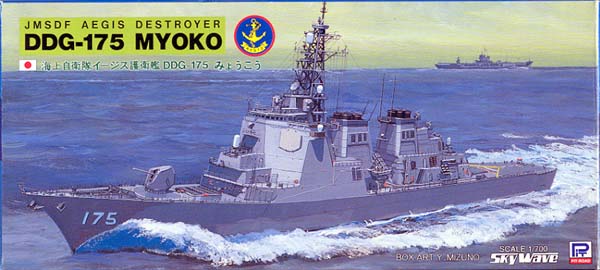
Reviewed by Jeff Hughes

| The first foreign country to acquire
the US Aegis radar technology was the Japanese. They used it in their
Kongo Class DDG's, the first ship entered service in 1993, the fourth and
last joined the JMSDF in 1998. The ships have a dual purpose, to
assist in the aerial defense of their country and provide AAW support for
their strong ASW task groups.
The Kongo's are essentially an enlarged version of the USN Arleigh Burke class DDG. Armament consists of: 1 127mm (5 inch) 54 cal OTOBreda Dual Purpose gun
Some of the differences between the JMSDF Kongo's and the USN Burkes are that the Kongo's employ a separate fire-control system for the 127-mm gun, which has a faster firing rate than the USN standard Mk 45 127-mm gun, a back-up surface/air search radar, a more elaborate EW system and while they have the capability to act as a helicopter platform they do not have a haul down system. Full displacement on the Kongo's is larger, 9,485 tons to 8,500 tons and is some 78 feet longer and 2 feet wider. Currently there is the possibility that at least four more Kongo Class DDG will be constructed, these four will be able to house at least one SH-60J ASW helicopter, much like the USN Burke Flight IIA's. |
||||
| The Skywave kit, J16, DDG 175 JMSDF Myoko, represents the third Kongo class. It comes as a waterline only, standard Skywave practice. It is like most other Skywave kits molded in light gray with little to no flash and excellent detail throughout. The hull and part of the forward superstructure are molded in one piece with the bow as an insert. The surface detail matches pretty well with published pictures that are at my disposal. The kit has 68 parts on one sprue and the hull and bottom of the hull rubber banded together. Unfortunately, this kit does not come with the excellent modern weapons sprue with so many extra goodies for those experimental ships and/or scratch building. | ||||
| .The mast appears to be pretty decently molded, but as with any injection molded kit could be better represented with brass rod and some PE. The aft helicopter pad is molded with a rough texture to try and simulate the anti-skid surfaces found on modern ships. While slightly over scaled I like the attempt and can't wait to see what it will look like painted. I can only hope they will continue this trend for any future modern ships Skywave releases. For once there are no raised lines to represent the landing pad markings molded on. Unfortunately, as shown in the directions on the back of the box the red semi circle of the landing markings fall right across the aft Mk-41 VLS. Trying to get this to lie correctly on the model will not be fun. I was not able to see a red semi-circle in any of the pictures that showed this area. More research on this item is required. The bow insert joint line will be easy to hide. It butts up against the forward superstructure and separate pieces will be glued onto this superstructure thus hiding the seam line. |
to enlarge  |
|||
| The kit contains decals to represent either the Myoko, DDG 175 or the Chokai, DDG176. According to the directions there is no difference between these two ships. The decals are sharp and the printing is excellent. |  |
|||
 |
||||
The instructions are typical Skywave, very little English
but the pictures are easy enough to follow and there is enough English
to get you through the building of the model.
|
||||
| It is a great looking kit with out PE but Skywave does have a PE kit
for the radars, masts and such, kit # PE-115. It does not contain
railing for that you could use any of the aftermarket 1/700 sets available.
Once again the box art by Y. Mizuno is wonderful. |
||||
| References:
The Naval Institute Guide to Combat Fleets of the World 1998-1999
|
 |
|||

© ModelWarships.com |
||||